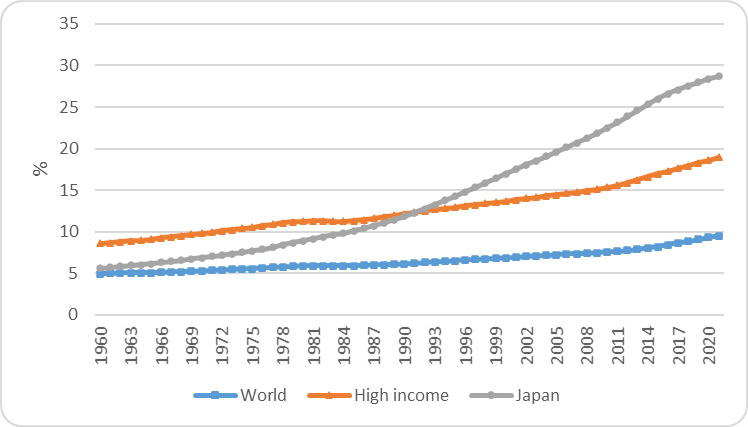Japan's Aging Workforce: Impact on Occupational Accidents*
09/152023
Author: Farhad Taghizadeh-Hesary
Introduction and Background:
Statistics indicate that the global population is undergoing an aging process, albeit at varying rates among countries. Between 1960 and 2021, the proportion of the world's population aged 65 years and older increased from 4.9% to 9.5%. In contrast, high-income countries witnessed a more pronounced rise in this age group, from 8.6% to 19% over the same period. Figure 1 illustrates this trend, highlighting Japan as a standout example among high-income nations, experiencing earlier and swifter population aging, with its elderly population growing from 5.6% in 1960 to 28.7% in 2021.
Numerous studies have delved into various facets of how population aging affects the social and economic landscapes of countries. Some investigations have focused on the ramifications of population aging for industries and education. Lin et al. (2020) have underscored that demographic imbalances frequently lie at the core of a nation's challenges, with population-related issues often culminating in social instability.

In Japan, a super-aging society, there has been a notable increase in occupational accidents (OAs). Both developed, and developing countries should gain a comprehensive understanding of the implications of population aging on the labor market and the economy. In a recent study by Pourrostami, Taghizadeh-Hesary, and Mehrizi (2023), a theoretical and empirical macroeconomic model is proposed to investigate the influence of various factors on OA based on labor supply theory. To empirically estimate this model, an autoregressive distributed lag-bounds testing approach was employed, utilizing data from Japan spanning the years 1961 to 2019.
Major findings and Policy implications:
The results from Pourrostami, Taghizadeh-Hesary, and Mehrizi's study in 2023 confirm several key findings regarding the impact of various factors on OAs. The study sheds light on how population aging affects the labor market and offers practical policy recommendations, highlighting the following insights:
I. Long-term estimates reveal that an increase in new capital per working-age population, serving as a proxy for investments in preventive measures, significantly reduces OAs. Conversely, short-term estimates do not confirm this relationship. The study also demonstrates that increased per capita investment, especially in conjunction with emerging technologies like robotics, leads to a reduction in OAs.
II. The influence of per worker effort, as proxied by average working hours, on OAs is notably positive in both the short and long run. This finding aligns with expectations, given the presence of Karoshi in Japan. Prolonged working hours, which contribute to fatigue from overwork and diminished mental and nervous health, serve as a fundamental factor behind OAs.
III. The current level of the aged labor supply share has a positive impact on OAs in the short term. However, long-term estimations indicate a negative influence of the aged labor supply share on OAs. This underscores the importance of government policies, such as implementing 5-year preventive plans and other laws and regulations, to manage OAs over the long term. The study's findings reveal that while elderly labor contributes positively to OAs in the short term, it ultimately reduces OAs in the long term due to workforce occupational training requirements.
Companies, particularly those in the manufacturing sector, need to prioritize safety and health considerations in their investments and provide adequate job training to mitigate OAs.
Based on the current research findings, the following policy recommendations are suggested:
I. Japan's experience underscores the significance of workplace preventive plans and regulations. Policymakers should consider implementing capacity-building initiatives, along with rules, regulations, and prevention plans, in countries grappling with aging populations. These efforts aim to enhance stakeholder awareness regarding the potential costs associated with OA.
II. Investments in industrial accident prevention measures can effectively reduce the incidence of OA. Governments should encourage the private sector to participate in these projects by offering higher returns on investment and minimizing associated risks.
III. The adoption of robots can offer substantial benefits to all societies, with a particularly notable impact on aging populations like Japan. Embracing robotic technologies enhances the productivity of older workers and concurrently diminishes the occurrence of OA.
References
Lin CJ, Chang HM, Hung CJ (2020) The impact of low fertility in East Asia: A case study of low fertility crisis management in Japan. Asian J Educ Soc Stud 6:11–18. https://doi.org/10.9734/ajess/2020/v6i130165
Pourrostami, N., Taghizadeh-Hesary, F. & Mehrizi, F. Z. (2023). Population aging and working hour impacts on occupational accidents: evidence from Japan. Economic Change and Restructuring. https://doi.org/10.1007/s10644-023-09526-4
*The full version of this study is available at: Pourrostami, N., Taghizadeh-Hesary, F. & Mehrizi, F. Z. (2023). Population aging and working hour impacts on occupational accidents: evidence from Japan. Economic Change and Restructuring. https://doi.org/10.1007/s10644-023-09526-4
